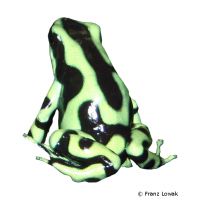Golden Dart Frog (Dendrobates auratus)
| Golden Dart Frog Dendrobates auratus | |
|---|---|
| Name | Golden Dart Frog |
| Name Lat. | Dendrobates auratus |
| Family | Dendrobatids |
| Family lat. | Dendrobatidae |
| Order | Frogs & Toads |
| Order lat. | Anura |
| Origin | Central America |
| Habitat | Rainforest |
| Diet | Small live insects |
| Humidity | 70-100 % |
| Behavior | Territorial |
| Keeping | Pair, group |
| Care Level | Moderate |
| Breeding | Moderately difficult |
| Housing | Rainforest terrarium |
| Life Span | 5-10 years |
| Protection | CITES Appendix II; EU Annex B |
| Metric Units | |
| Size | 4 cm |
| Temperature | 25-28 °C |
| Housing Size | 40 x 30 x 35 cm |
| US Units | |
| Size | 1.6" |
| Temperature | 77-82 °F |
| Housing Size | 15" x 10" x 15" |
Distribution and habitat
The distribution range of the diurnal, ground-dwelling golden tree climber frogs extends from Costa Rica through Panama to northwestern Colombia. The coloration of the animals varies according to their origin. They live primarily in lowland rainforests near bodies of water (ponds, pools, etc.), but can also be found at elevations up to 1,000 meters. They are also native to Hawaii, where they were released in early 1930 on the island of Oahu for mosquito control.
Maintenance
For 1-2 animals, the minimum terrarium area is 1,200 cm², with a minimum effective height (measured without substrate) of 25 cm. This corresponds to a base area of e.g. 40 x 30 cm. For each additional animal, provide an additional 400 cm² of space. The terrarium should be placed in a quiet place without sunlight.
You need a terrarium with a substrate of loose, absorbent, non-rotting substrate such as sand-peat mixture, coconut fibers or sphagnum moss with a drainage and a shallow, 3-5 cm deep watering place, in addition branched climbing branches, preferably entwined by climbing plants, with horizontal perches, back and side wall coverings of e.g.E.g. tree fern plates (Xaxim) and a dense planting (e.g. Tradescantia, Ficus, Scindapsus, ferns, Bromeliads). At least twice a day the inside of the terrarium must be finely sprayed with water (humidity), but a rain or mist system is better.
| Temp. day: 25-28 °C | Temp. night: 22-24 °C | Humidity: 70-100 |
The lighting duration must be 10-14 hours depending on the season. Daylight fluorescent tubes with low UV content are very suitable.
Diet
The food supply consists of live, small insects such as ants, spiders, micro crickets, tiny grasshoppers and crickets, springtails, enchytraea and drosophila. Food should be offered to adults 2-3 times per week, young animals must be fed daily. It is important to add minerals and vitamins regularly (e.g. by dusting the feed animals). The quality of the feed animals can be enhanced by feeding overripe fruit and honey water
A varied diet promotes health and prevents deficiency symptoms.
Reproduction and breeding
The heart-shaped adhesive discs of the males are significantly larger at sexual maturity on the 2nd, 3rd and 4th fingers than in the larger and more plump females. The spawn, up to 10 eggs, is deposited in a brood cavity (e.g. half coconut shell) where it is fertilized by the male. After 10-14 days at 22-24 °C the larvae hatch. The parents perform brood care and carry each larva (tadpole) on their backs out of the brood burrow into a small water body (e.g. leaf axils of bromeliads). After about 60-72 days the transformation (metamorphosis) is completed and the frog leaves the water. The breeding of the tadpoles in small plastic boxes filled with water has proven to be successful. They are fed with algae growth, dry fish food and chicken egg yolk.
Species protection
They are exempt from the obligation to notify (Federal Species Protection Ordinance Annex 5 to § 7 Para. 2). It is essential to find out about any bans on keeping or permits for keeping dangerous animals in your federal state or municipality (e.g. public order office)
Protection of species: WA Appendix II; EU Appendix B. The proof of purchase is the required proof of origin for the animal. Please keep it safe! Your pet store will be happy to provide you with further information.
Important
Only in the wild they have a skin toxin, which is absorbed through the food of poisonous insects and converted into the body's own toxin. Therefore they lose their skin poison after some time in terrarium keeping. Offsprings are non-poisonous. Prior to purchase, a terrarium should be prepared that meets the species specific needs. Necessary are good ventilation without drafts and equipment for measuring temperature and humidity. The lighting has to correspond to the species-specific day-night rhythm and should be placed in such a way that the animals cannot injure themselves. The terrarium should be locked in such a way that neither unauthorized persons can open it nor the animals can escape. Special attention should be paid to thorough hygiene and impurities should be removed regularly. Further literature can be found in your pet store.
References
Text: petdata; Image: Franz Lowak
Source: ENGELMANN (2006): Zootierhaltung - Tiere in menschlicher Obhut: Reptilien und Amphibien, Harri Deutsch Verlag; VDA & DGHT (2006): Haltungsrichtlinien für die Haltung von Anuren
- Gemäß § 21 Abs. 5 Tierschutzgesetz idgF
